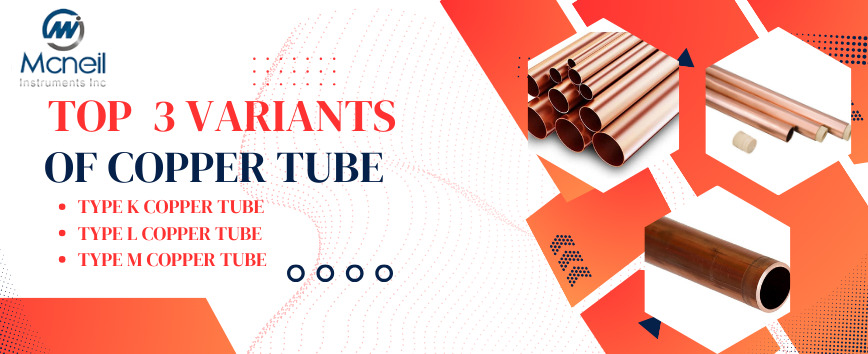The manufacturing process of copper tubes involves several steps, and different methods are depending on the type of tube required. Here’s a general overview of the manufacturing process for seamless copper tubes:
Extraction of Copper: Copper is typically extracted from copper ores through processes like mining and smelting to obtain copper concentrate.
Casting and Forming: The extracted copper is melted in a furnace and cast into cylindrical billets or logs. These logs are then hot extruded to form tube-like shapes. This extrusion process involves forcing the copper through a die, giving it the desired shape and dimensions.
Drawing: The extruded tubes are drawn through a series of dies to further reduce their diameter and thickness. This process is repeated several times until the tubes reach the desired dimensions. Drawing also imparts additional strength and improves the surface finish of the tubes.
Annealing: After the drawing process, the tubes undergo annealing. Annealing involves heating the tubes to a specific temperature and then slowly cooling them. This step helps relieve stresses generated during the manufacturing process, enhances the tubes’ ductility, and improves their mechanical properties.
Cleaning and Coating: The tubes are thoroughly cleaned to remove any residues or impurities. Depending on the application, the tubes may be coated or treated with substances to prevent corrosion.
Cutting and Packaging: The tubes are cut into specific lengths based on customer requirements. The final step involves packaging the tubes for distribution.
It’s important to note that for some applications, such as in air conditioning and refrigeration, copper tubes may also be manufactured through a process called “tube drawing.” In this method, a copper billet is pierced to create a hollow tube, which is then drawn through a series of dies to achieve the desired dimensions.
The manufacturing process may vary for welded or brazed copper tubes, where the tube is formed by welding or brazing a flat strip of copper into a tubular shape.
Quality control measures are implemented throughout the manufacturing process to ensure that the copper tubes meet industry standards and specifications.
What are the three common types of copper tube?
The three common types of copper tubes are categorized based on their wall thickness, and they are known as Type K, Type L, and Type M. These types are widely used in various applications, particularly in plumbing and HVAC systems. Here’s an overview of each type:
Type K Copper Tube:
Description: Type K is the thickest-walled copper tube among the common types. It has a green stripe or color code to distinguish it.
Application: Type K is often used in applications where high durability and resistance to external pressure are required. It is commonly used for water distribution systems, especially in underground installations.
Common Use Cases: Municipal water supply lines, underground water service lines.
Type L Copper Tube:
Description: Type L has a medium wall thickness and is easily identified by its blue stripe or color code.
Application: Type L is suitable for both interior and exterior applications. It offers a good balance between strength and cost-effectiveness.
Common Use Cases: Residential and commercial plumbing, water distribution systems, heating systems.
Type M Copper Tube:
Description: Type M has the thinnest walls among the common types and is marked with a red stripe or color code.
Application: Type M is cost-effective and is commonly used in applications where pressure is not as high. It is suitable for residential plumbing.
Common Use Cases: Domestic water service lines, refrigeration, air conditioning.
These types are standardized by industry organizations such as ASTM International and the American Water Works Association (AWWA). The specifications for each type include the dimensions, thickness, and other mechanical properties, ensuring that they meet specific requirements for their intended applications.
Specifications and Standards of Good Quality Copper Tubes
Quality copper tubes typically adhere to specific specifications and standards to ensure their performance and durability. Here are some common specifications for quality copper tubes:
- ASTM B88: This is the standard specification for seamless copper water tube, suitable for general plumbing and similar applications. It covers various dimensions, tolerances, and requirements for seamless copper tubes used in water distribution systems.
- ASTM B280: This specification covers seamless copper tube for air conditioning and refrigeration systems. It includes requirements for dimensions, tolerances, mechanical properties, and cleanliness of the tubes to ensure their suitability for use in HVACR applications.
- ASTM B75: This specification covers seamless copper tube for use in plumbing applications. It includes requirements for dimensions, tolerances, mechanical properties, and chemical composition of the tubes to ensure their quality and performance in plumbing systems.
- EN 1057: This European standard specifies requirements for copper and copper alloys seamless, round tubes for water and gas in sanitary and heating applications. It covers dimensions, tolerances, mechanical properties, and testing methods for copper tubes used in plumbing and heating systems.
- JIS H3300: This Japanese Industrial Standard specifies seamless copper and copper alloy tubes for general use. It includes requirements for dimensions, tolerances, mechanical properties, and chemical composition of the tubes used in various applications, including plumbing, HVAC, and industrial processes.
- BS EN 12735-1: This British standard specifies copper and copper alloy seamless, round tubes for general purposes. It covers requirements for dimensions, tolerances, mechanical properties, and testing methods for copper tubes used in a wide range of applications.
In addition to these specifications, quality copper tubes may also be certified by organizations such as the International Organization for Standardization (ISO) or the Copper Development Association (CDA) to ensure compliance with industry standards and regulations.
When purchasing copper tubes, it’s essential to verify that they meet the required specifications for your specific application to ensure their quality, performance, and longevity. Working with reputable suppliers and manufacturers who provide certified products can help ensure that you receive high-quality copper tubes that meet your needs and standards.








